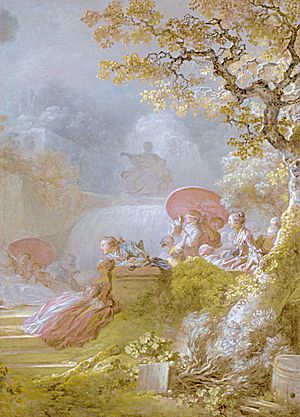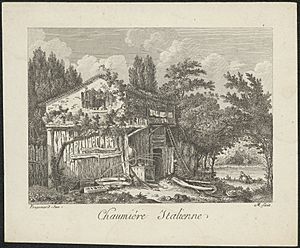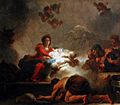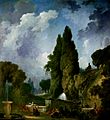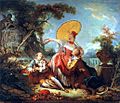Jean-Honoré Fragonard facts for kids
Quick facts for kids
Jean-Honoré Fragonard
|
|
|---|---|
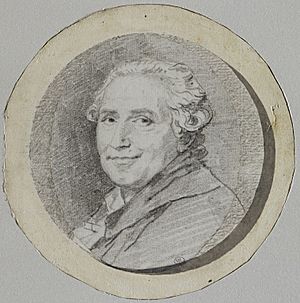
Self-Portrait, 1780s, black chalk with gray wash
|
|
| Born | 5 April 1732 Grasse, France
|
| Died | 22 August 1806 (aged 74) Paris, France
|
| Education |
French Academy in Rome |
| Known for | Painting, drawing, etching |
|
Notable work
|
The Swing, A Young Girl Reading, The Bolt |
| Movement | Rococo |
| Spouse(s) |
Marie-Anne Fragonard (née Gérard)
(m. 1768) |
| Awards | Prix de Rome |
Jean-Honoré Fragonard (born April 5, 1732 – died August 22, 1806) was a famous French painter and printmaker. He was known for his lively and energetic style, which was part of the late Rococo art movement.
Fragonard was a very busy artist in the years leading up to the French Revolution. He created more than 550 paintings, plus many drawings and etchings. It's interesting that only five of his paintings have a date on them!
Contents
About Jean-Honoré Fragonard

Jean-Honoré Fragonard was born in Grasse, France. His father, François Fragonard, was a glover.
Early Life and Training
When Fragonard was eighteen, his father faced money problems. Jean-Honoré started working for a lawyer in Paris. But he showed such a strong talent for art that he was sent to study with the famous painter François Boucher.
Boucher saw Fragonard's amazing skills. He sent him to Chardin's art studio for six months. After that, Fragonard returned to Boucher. He quickly learned Boucher's style so well that Boucher trusted him to make copies of his own paintings.
Studying in Rome
Even though he wasn't yet a student at the official art academy, Fragonard won the important Prix de Rome award in 1752. He won it with his painting Jeroboam Sacrificing to Idols. Before going to Rome, he spent three more years studying with Charles-André van Loo.
In 1756, Fragonard moved to the French Academy in Rome. While there, he became good friends with another painter, Hubert Robert. In 1760, they traveled around Italy together. They drew many sketches of the beautiful scenery, especially the romantic gardens with their fountains and temples.
Fragonard also admired the works of Dutch and Flemish masters like Rubens and Rembrandt. He learned to use loose and strong brushstrokes from them. He was also very impressed by the rich and grand paintings of Giovanni Battista Tiepolo in Venice.
Becoming Famous
In 1765, Fragonard's painting Coresus et Callirhoe helped him get into the Academy. The king even bought this painting!
During this time, he painted many famous works. These include Blind Man's Bluff, The Bolt, and The Swing. He also decorated rooms for important people like Madame du Barry.
Family Life and Later Years
Fragonard married Marie-Anne Gérard in 1769. She was also an artist who painted tiny pictures called miniatures. They had a daughter named Rosalie Fragonard, who often modeled for her father's paintings.
In 1773, he traveled to Italy again. He returned to Paris in 1774, passing through several European cities.
In 1778, Marie-Anne's 14-year-old sister, Marguerite Gérard, became Fragonard's student and helper. In 1780, he had a son, Alexandre-Évariste Fragonard. His son also grew up to be a talented painter and sculptor.
The French Revolution began in 1789. This was a difficult time for Fragonard. His wealthy supporters faced difficulties or had to leave France. In 1790, Fragonard decided to leave Paris. He found a safe place to stay with his cousin in Grasse. He decorated his cousin's house with a series of beautiful paintings called Les progrès de l'amour dans le cœur d'une jeune fille (The Progress of Love in a Young Girl's Heart).
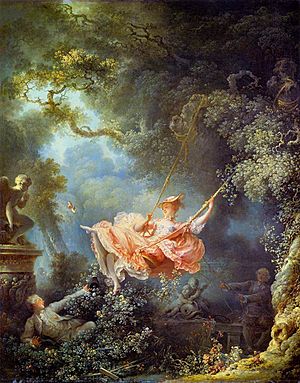
Fragonard returned to Paris in the early 1800s. He passed away in 1806, almost forgotten by the art world at that time.
Fragonard's Legacy
For many years after his death, Fragonard's art was not well-known. However, later art experts realized how important he was. Today, he is seen as one of the greatest French painters of all time.
His way of using colors and his bold brushstrokes influenced later artists, especially the Impressionists. These were painters like his grand-niece, Berthe Morisot, and Renoir. Fragonard's paintings, along with those of François Boucher, really capture the feeling of their time period.
The Swing
One of Fragonard's most famous paintings is The Swing. It's also known by its original title, The Happy Accidents of the Swing. This oil painting is a masterpiece of the Rococo art style.
The painting shows a young lady on a swing. Her husband is in the background, pushing her. A young man is secretly watching her from the bushes. As the lady swings high, she kicks off her shoe.
The story behind the painting is interesting. A young nobleman asked for a painting of his mistress on a swing. He first asked another artist, Gabriel François Doyen, but Doyen didn't want to paint such a playful scene. So, he gave the job to Fragonard instead.
Images for kids
-
Blind Man's Bluff, 1750–1752, Toledo Museum of Art, Toledo, Ohio
-
The See-Saw, 1750–1755, Thyssen-Bornemisza Museum, Madrid
-
The Musical Contest, 1754–55, Wallace Collection, London
-
Inspiration, 1769, Louvre, Paris
-
Portrait of a Man, the so-called Denis Diderot, 1769, Louvre, Paris
-
The Love Letter, 1770, Metropolitan Museum of Art, New York
-
The Secret Meeting, 1771, (former collection of Madame Du Barry), Frick Collection, New York
-
The Visit to the Nursery, c. 1775, National Gallery of Art, Washington, D.C.
-
A Young Girl Reading, c. 1776, National Gallery of Art, Washington, D.C.
-
Sisters, after 1778, Metropolitan Museum of Art. New York
-
The Grape Gatherer, 1754–1755, Detroit Institute of Art, Detroit, Michigan
See also
 In Spanish: Jean-Honoré Fragonard para niños
In Spanish: Jean-Honoré Fragonard para niños
- Honoré Fragonard
- History of painting
- Western painting
- Jeroboam Sacrificing to Idols


